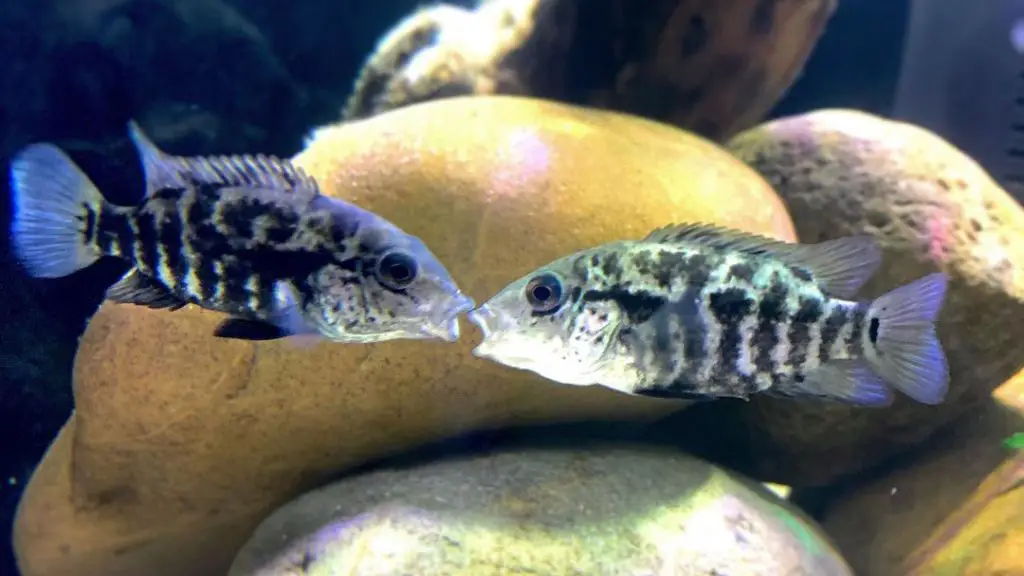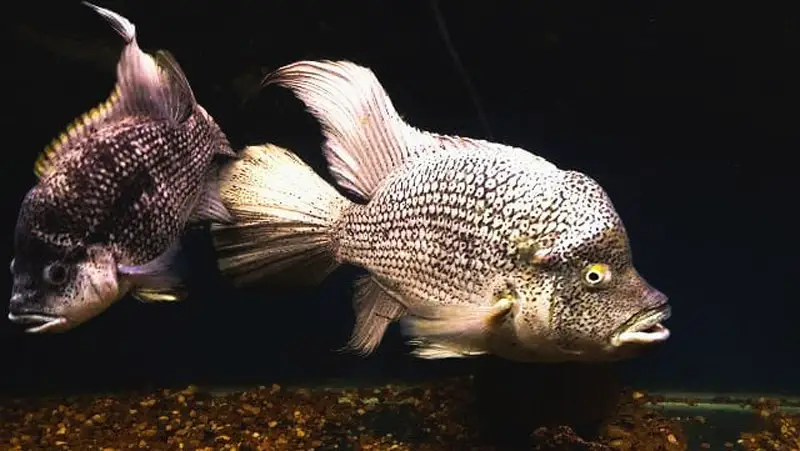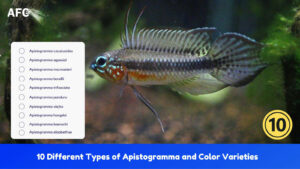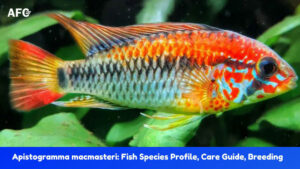Like most cichlids, the Haitian cichlid is an extremely unique cichlid among the aquarist community. It is also widely known as “black nasty” and its name tells you what they are – one of the most aggressive cichlids in this world.
If you’re looking for a large, solitary cichlid from the popular aquarium options, the black nasty could be exactly what you’re looking for. In this guide, you’ll learn everything about Haitian cichlid care. Managing the size and potential aggression of these fish can be tricky, but we cover it at length.
Read our guide to know the essential features of this violent species.
Species Summary

The Black Nasty Cichlid (Nandopsis haitiensis), also known as Haitian Cichlid, Odo Cichlid, is a big and beautiful species that originated in Haiti where it can be found in fast-moving rivers and streams. These fish are rare in the trade and are not often seen in the hobby, but they make an excellent addition for any advanced aquarist looking for a challenge.
Like many other large Central American Cichlid species, Black Nastys are not for the faint of heart. They are prone to extremely aggressive and will not hesitate to show it. And beyond that, they can reach massive sizes and require a very large aquarium.
Despite their aggression and sizes, Nasties are an amazing species that is a joy to watch. They are very active fish and have beautiful coloration.
| Origin: | Central America |
| Family: | Cichlidae |
| Scientific Name: | Nandopsis haitiensis |
| Common Name: | Black Nasty, Haitian Cichlid, Odo Cichlid |
| Size: | 14 inch (35 cm) sometimes up to 16 inches (40 cm) |
| Minimum Tank Size: | 105 gallons |
| Temperature: | 73 to 82°F (23.0 – 28.0 °C) |
| ph: | 7.0 to 9.0 |
| Water hardness: | 9 to 20 |
| Temperament: | Very Aggressive |
| Care level: | Advanced |
| Diet: | Omnivore |
Black Nasty Cichlid Lifespan
How long does Black Nasty Cichlid live for? The Black Nasty Cichlids live for 5-10 years. Considering the usual lifespans of fish, a decade is quite a long time for a species to stick around in an aquarium. They will be your buddy for years if you look after them well.
However, their lifespan depends on several parameters, majorly on how well you cater to their fundamental needs. Now, they are fairly easy to look after; you mainly need to take care of their aggression and the size of your tank as they grow up to be quite large.
You might be interested to read: 10 Most Popular Central American Cichlids with Pictures
Appearance
Also known as Odo fish, black nasty are typically seen in black and white colors. The males have a white body with black pepper-like spots, and females have a white mouth with a dominantly black body. They are large-sized and do not have prominent genitalia, which makes sexing them a little complicated.
The species’ nature can accurately be judged by its name itself, as they are black in appearance and have a nasty temperament. They are difficult to breed and, as a result, are difficult to get on the market.
How to Tell if My Black Nasty is Male or Female?
The sexes are slightly difficult to identify but can be demarcated by looking at the genitalia of the fish. Mature males have a hump on their heads, which distinguishes them from the other sex. They are much larger than their female counterparts and much more aggressive.
Females, on the other hand, are large as compared to other species but still smaller than the cichlid males. However, their genitalia are more prominent and rounder.
Black Nasty Cichlid Size
How Big do black nasty cichlids get? Black Nasty Cichlids grow up to 15 inches in size, and that is considered quite big in the category of aquarium fish. In the wild, some specimens can reach lengths of 16 inches.
Because of their colossal size, they need a bigger tank, frequent cleaning, and only a select few tankmates.
People look at baby cichlids and often get the impression of them being a small species, but that is definitely not the case. Their growth rate exponentially increases in the later stages of their life cycle.
Care and Tank Setup
First of all, count yourself lucky if you found a black nasty cichlid as it is not readily available on the market. Aquarists have to spend tons of hours researching where to get them from.
It is reasonably easy to take care of these giant fish types, provided you stay alert of their essential needs. The more challenging part is to sex them and find buddies to live with them in the tank, but we’ll get to that later.
Tank Size
With “no” other tank mates, for a single full-grown black nasty cichlid, we recommend the aquarium size to at least 105 gallons; A minimum sized aquarium of 120 gallons is suggested for a pair.
The size should be directly proportional to the number and ages of fish you’ll be keeping. Double or triple the aquarium size according to total fish, although we highly doubt if anyone can handle more than a pair in their tank.
Water Parameters
The Black Nasty Cichlid prefers medium-hard water, and is a very hardy fish that can withstand a wide range of water conditions. The best way to create an ideal living environment for your Black Nasty Cichlid is to replicate their natural habitat. Try to maintain the following water parameters, and your fish should have no problem thriving.
- Water temperature: 73 to 82°F (23.0 – 28.0 °C)
- pH levels: 7.0 to 9.0
- Water hardness: 9 to 20
Even though these fish are hardy, we still recommend that you invest in an accurate testing kit to ensure you’re getting correct readings so that the slightest change in their environment will not stress your nasties. Black nasty cichlids will also become more aggressive when stressed, so it is best to avoid any potential problems by keeping the water conditions stable.
As we discussed, this species is giant-sized, eats a lot, and consequently excretes a lot. That’s why it’s crucial to filter the water regularly and aerate it well, keeping moderate hardness.
Author note: As always, invest in a reliable surface skimmer to get the most out of your aquarium.
The aquarium should be heated, depending on your area’s climate. You can use an aquarium heater to maintain the desired temperature within the range. However, If there’s one thing I’ve learned from my experience with these fish it’s that they can burn themselves on the heater, some even break the heater. So it’s smart to put the heater in the sump or purchase a heater guard to prevent accidents.
Plants and Decor
Plant your tank in such a way that there are natural borders for the territory for each of your fish. This will ensure that every specimen gets its own space to feed, dwell, and rest without disturbing the others.
Black Nasty Cichlid needs a lot of hiding places to rest peacefully, or else they tend to get even more aggressive than usual. Fill your tank with hardy plants like Crinum or tough ferns like Java, as the species won’t eat them, and borders will be maintained.
When you’re arranging the tank, avoid too many large decorations as this species is very boisterous and will get hurt on any items that get in their way. Stick to small to medium-sized objects and you should be good.
Common & Potential Diseases
Aquarium fish are prone to developing infectious diseases, and their treatment can take up a lot of time and energy. A few disorders commonly found in Haitian Cichlids are:
- Swim bladder disease
- Cotton wool disease
- White Spot – Ich
Food & Diet
Black nasty cichlids are omnivore species, which means they eat whatever comes their way, be it plants or other small creatures. Make sure that you give your fish a varied diet with both plant and meat content.
It should be noted that this species tends to have a digestive disorder. Many foods can lead to serious gastrointestinal issues, such as freeze dried krill and brine shrimp.
Feeding your fish on a set schedule with the correct amount is critical to avoiding overfeeding and maintaining their health. Sudden changes in the diet will stress the fish and make them susceptible to bloat. Black nasties grow very quickly, so don’t be surprised if you see them gulping down food voraciously.
Black Nasty Cichlid Tank Mates

Keeping small or medium sized fish species near these aggressive beings is a huge no. They are lone dwellers but survive best when kept singly or as a pair.
Furthermore, it’ll be smart to create visual barriers in your aquarium so that the black nasties don’t see their tankmates directly. These fish are legitimately the anti-social cranky beings of the aquatic kingdom.
Breeding
These creatures aren’t bred regularly because of which they are pretty scarce. Breeding black nasties is particularly a task as you already know that they do not get along very well with their partners and are picky when it comes to mating. Your best bet to breed them is by keeping the pair together since their young phase.
Conclusion
Well, that’s about it for our guide on this fatally beautiful species. To wrap it up, we’ll say black nasty cichlids are a good companion if you are fond of big fish.
However, they are one of the most sensitive cichlids, and even a small change in their environment can lead to stress. So, if you’re a beginner, we would recommend that you steer clear of these guys.
We’re always looking for ways to make this care guide even better! If you have any ideas on what else we could add, please don’t hesitate in letting us know.






2 thoughts on “Black Nasty Cichlid Care 101: Size, Tank Mates, Food & Other Tips”
We’re can I get a black nasty ciclid from?im out here in Philadelphia
If you aren’t able to find a breeder locally, ordering online is possibly the only way to get this species.
You can find one by looking at these specialists like COA, Jeff Rapps, Dave’s Rare Ciclids, and Wet Spot.
Good luck!